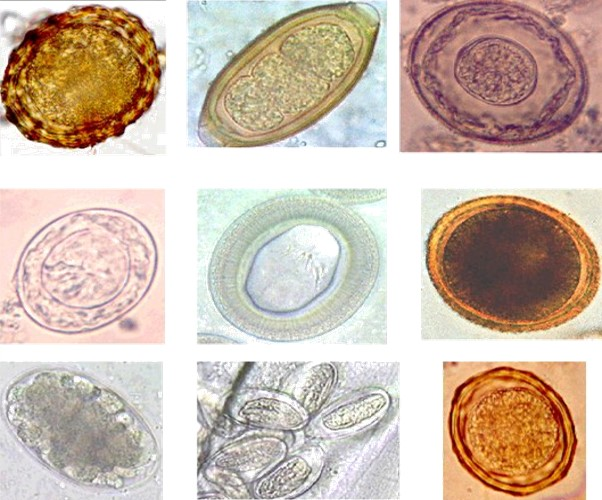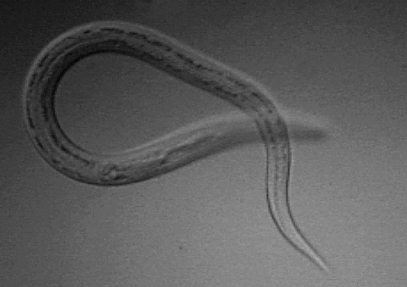|
Trichuriasis
Trichuriasis, also known as whipworm infection, is an infection by the parasitic worm '' Trichuris trichiura'' (whipworm). If the infection is only with a few worms, there are often no symptoms. In those who are infected with many worms, there may be abdominal pain, fatigue and diarrhea. The diarrhea sometimes contains blood. Infections in children may cause poor intellectual and physical development. Low red blood cell levels may occur due to loss of blood. The disease usually spreads when people eat food or drink water containing these worms' eggs. This may occur when contaminated vegetables are not fully cleaned or cooked. Often these eggs are in the soil in areas where people defecate outside and where untreated human feces is used as fertilizer. These eggs originate from the feces of infected people. Young children playing in such soil and putting their hands in their mouths also become infected easily. The worms live in the large bowel and are about four centimetres in ... [...More Info...] [...Related Items...] OR: [Wikipedia] [Google] [Baidu] [Amazon] |
Soil-transmitted Helminthiasis
Soil-transmitted helminthiasis is a type of worm infection (helminthiasis) caused by different species of roundworms. It is caused specifically by worms transmitted through soil contaminated with faecal matter and are known as soil-transmitted helminths. Three types of soil-transmitted helminthiasis can be distinguished: ascariasis, hookworm infection and whipworm infection. These three types of infection are therefore caused by the large roundworm '' A. lumbricoides, ''the hookworms'' Necator americanus ''or'' Ancylostoma duodenale'' and by the whipworm '' Trichuris trichiura''. It has become the most common parasitic disease of humans worldwide. Approximately two billion people (about a fourth of global population) are infected as of the latest estimate, and four billion at risk, surpassing even the all-time most prevalent parasitic disease, malaria. The largest numbers of cases occur in impoverished rural areas of Sub-Saharan Africa, Latin America, Southeast Asia, and Chi ... [...More Info...] [...Related Items...] OR: [Wikipedia] [Google] [Baidu] [Amazon] |
Neglected Tropical Disease
Neglected tropical diseases (NTDs) are a diverse group of tropical infections that are common in low-income populations in developing regions of Africa, Asia, and the Americas. They are caused by a variety of pathogens, such as viruses, bacteria, protozoa, and parasitic worms (helminths). These diseases are contrasted with the "big three" infectious diseases (HIV/AIDS, tuberculosis, and malaria), which generally receive greater treatment and research funding. In sub-Saharan Africa, disease burden, the effect of neglected tropical diseases as a group is comparable to that of malaria and tuberculosis. NTD co-infection can also make HIV/AIDS and tuberculosis more deadly. Some treatments for NTDs are relatively inexpensive. For example, praziquantel for schistosomiasis costs about US $0.20 per child per year. Nevertheless, in 2010 it was estimated that control of neglected diseases would require funding of between US$2 billion and $3 billion over the subsequent five to sev ... [...More Info...] [...Related Items...] OR: [Wikipedia] [Google] [Baidu] [Amazon] |
Parasitic Worm
Parasitic worms, also known as helminths, are a polyphyletic group of large macroparasites; adults can generally be seen with the naked eye. Many are intestinal worms that are soil-transmitted and infect the gastrointestinal tract. Other parasitic worms such as schistosomes reside in blood vessels. Some parasitic worms, including leeches and monogeneans, are ectoparasites thus, they are not classified as helminths, which are endoparasites. Parasitic worms live in and feed in living hosts. They receive nourishment and protection while disrupting their hosts' ability to absorb nutrients. This can cause weakness and disease in the host, and poses a global health and economic problem. Parasitic worms cannot reproduce entirely within their host's body; they have a life cycle that includes some stages that need to take place outside of the host. Helminths are able to survive in their mammalian hosts for many years due to their ability to manipulate the host's immune respon ... [...More Info...] [...Related Items...] OR: [Wikipedia] [Google] [Baidu] [Amazon] |
Trichuris Trichiura
''Trichuris trichiura, Trichocephalus trichiuris'' or whipworm, is a parasitic roundworm (a type of helminth) that causes trichuriasis (a type of helminthiasis which is one of the neglected tropical diseases) when it infects a human large intestine. It is commonly known as the ''whipworm'' which refers to the shape of the worm; it looks like a whip with wider "handles" at the posterior end. The helminth is also known to cause rectal prolapse. Life cycle The female ''T. trichiura'' produces 2,000–10,000 single-celled eggs per day. Eggs are deposited from human feces to soil where, after two to three weeks, they become embryonated and enter the "infective" stage. These embryonated infective eggs are ingested by hand-mouth or through fomites and hatch in the human small intestine, exploiting the intestinal microflora as a stimulus to hatching. This is the location of growth and molting. The infective larvae penetrate the villi and continue to develop in the small intestine. ... [...More Info...] [...Related Items...] OR: [Wikipedia] [Google] [Baidu] [Amazon] |
Albendazole
Albendazole is a broad-spectrum antihelmintic and antiprotozoal agent of the benzimidazole type. It is used for the treatment of a variety of intestinal parasite infections, including ascariasis, pinworm infection, hookworm infection, trichuriasis, strongyloidiasis, taeniasis, clonorchiasis, opisthorchiasis, cutaneous larva migrans, giardiasis, and gnathostomiasis, among other diseases. Common side effects include nausea, abdominal pain, and headache. Rare but potentially serious side effects include bone marrow suppression which usually improves on discontinuing the medication. Hepatitis, Liver inflammation has been reported and those with prior liver problems are at greater risk. It is pregnancy category D in Australia, meaning it may cause harm if taken by pregnant women. Albendazole was developed in 1975. It is on the WHO Model List of Essential Medicines, World Health Organization's List of Essential Medicines. Albendazole is available in a fixed-dose combination with ... [...More Info...] [...Related Items...] OR: [Wikipedia] [Google] [Baidu] [Amazon] |
Ivermectin
Ivermectin is an antiparasitic drug. After its discovery in 1975, its first uses were in veterinary medicine to prevent and treat heartworm and acariasis. Approved for human use in 1987, it is used to treat infestations including head lice, scabies, river blindness (onchocerciasis), strongyloidiasis, trichuriasis, ascariasis and lymphatic filariasis. It works through many mechanisms to kill the targeted parasites, and can be taken by mouth, or applied to the skin for external infestations. It belongs to the avermectin family of medications. William Campbell and Satoshi Ōmura were awarded the 2015 Nobel Prize in Physiology or Medicine for its discovery and applications. It is on the World Health Organization's List of Essential Medicines, and is approved by the US Food and Drug Administration (FDA) as an antiparasitic agent. In 2022, it was the 314th most commonly prescribed medication in the United States, with more than 200,000 prescriptions. It is available as ... [...More Info...] [...Related Items...] OR: [Wikipedia] [Google] [Baidu] [Amazon] |
Hookworm
Hookworms are Gastrointestinal tract, intestinal, Hematophagy, blood-feeding, parasitic Nematode, roundworms that cause types of infection known as helminthiases. Hookworm infection is found in many parts of the world, and is common in areas with poor access to adequate water, sanitation, and hygiene. In humans, infections are caused by two main species of roundworm, belonging to the genera ''Ancylostoma'' and ''Necator (nematode), Necator''. In other animals the main parasites are species of ''Ancylostoma''. Hookworm is closely associated with poverty because it is most often found in impoverished areas, and its symptoms promote poverty through the educational and health effects it has on children. It is the leading cause of anemia and undernutrition in developing countries, while being one of the most commonly occurring diseases among poor people. Hookworm thrives in areas where rainfall is sufficient and keeps the soil from drying out, and where temperatures are higher, making r ... [...More Info...] [...Related Items...] OR: [Wikipedia] [Google] [Baidu] [Amazon] |
Sanitation
Sanitation refers to public health conditions related to clean drinking water and treatment and disposal of human excreta and sewage. Preventing human contact with feces is part of sanitation, as is hand washing with soap. Sanitation systems aim to protect human health by providing a clean environment that will stop the transmission of disease, especially through the fecal–oral route.SuSanA (2008)Towards more sustainable sanitation solutions . Sustainable Sanitation Alliance (SuSanA) For example, diarrhea, a main cause of malnutrition and stunted growth in children, can be reduced through adequate sanitation. There are many other diseases which are easily transmitted in communities that have low levels of sanitation, such as ascariasis (a type of intestinal worm infection or helminthiasis), cholera, hepatitis, polio, schistosomiasis, and trachoma, to name just a few. A range of sanitation technologies and approaches exists. Some examples are community-led total sanita ... [...More Info...] [...Related Items...] OR: [Wikipedia] [Google] [Baidu] [Amazon] |
Toilets
A toilet is a piece of sanitary hardware that collects human waste (urine and Human feces, feces) and sometimes toilet paper, usually for disposal. Flush toilets use water, while dry toilet, dry or non-flush toilets do not. They can be designed for a sitting position popular in Europe and North America with a toilet seat, with Accessible toilet, additional considerations for those with disabilities, or for a squatting posture more popular in Asia, known as a squat toilet. In urban areas, flush toilets are usually connected to a sewer system; in isolated areas, to a septic tank. The waste is known as ''Blackwater (waste), blackwater'' and the combined effluent, including other sources, is sewage. Dry toilets are Pit latrine, connected to a pit, Container-based sanitation, removable container, Composting toilet, composting chamber, or other storage and treatment device, including urine diversion with a Urine-diverting dry toilet, urine-diverting toilet. "Toilet (room), Toilet" ... [...More Info...] [...Related Items...] OR: [Wikipedia] [Google] [Baidu] [Amazon] |
Tropics
The tropics are the regions of Earth surrounding the equator, where the sun may shine directly overhead. This contrasts with the temperate or polar regions of Earth, where the Sun can never be directly overhead. This is because of Earth's axial tilt; the width of the tropics (in latitude) is twice the tilt. The tropics are also referred to as the tropical zone and the torrid zone (see geographical zone). Due to the overhead sun, the tropics receive the most solar energy over the course of the year, and consequently have the highest temperatures on the planet. Even when not directly overhead, the sun is still close to overhead throughout the year, therefore the tropics also have the lowest seasonal variation on the planet; "winter" and "summer" lose their temperature contrast. Instead, seasons are more commonly divided by precipitation variations than by temperature variations. The tropics maintain wide diversity of local climates, such as rain forests, monsoons, sa ... [...More Info...] [...Related Items...] OR: [Wikipedia] [Google] [Baidu] [Amazon] |
Infectious Disease (medical Specialty)
Infectious diseases (ID), also known as infectiology, is a medical specialty dealing with the diagnosis and treatment of infections. An infectious diseases specialist's practice consists of managing nosocomial (Hospital-acquired infection, healthcare-acquired) infections or community-acquired infections. An ID specialist investigates and determines the cause of a disease (bacteria, virus, parasite, fungus or prions). Once the cause is known, an ID specialist can then run various tests to determine the best drug to treat the disease. While infectious diseases have always been around, the infectious disease specialty did not exist until the late 1900s after scientists and physicians in the 19th century paved the way with research on the sources of infectious disease and the development of vaccines. Scope Infectious diseases specialists typically serve as consultants to other physicians in cases of complex infections, and often manage patients with HIV/AIDS and other forms of immuno ... [...More Info...] [...Related Items...] OR: [Wikipedia] [Google] [Baidu] [Amazon] |








